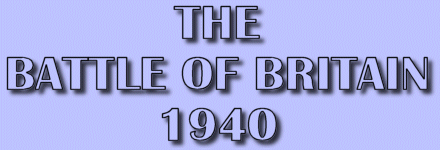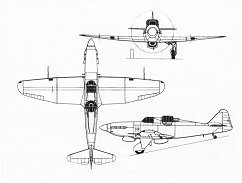


|
Page-9
|
|
Gloster Gladiator Hawker Hurricane Supermarine Spitfire Bristol Blenheim |
 |
 |
Boulton Paul Defiant |
|
Specification F.9/35 called for a two seater
fighter. The pilot occupying the front, while a gunner occupied the rear
with a swinging turret. The result was the acceptance of the Defiant built
by the Boulton Paul Aircraft Company, which took over the aviation department
of the Boulton and Paul Aircraft Company in June 1934.
Initially, delays in production meant that the first Defiants did not enter RAF squadron service until the December of 1939. With many pilots now getting used to the Spitfire and the Hurricane that had only recently been delivered to squadrons, first glimpses of the Defiant by the pilots indicated that the plane would be looking to a good future. The range of the Defiant was reasonably good, more than the Spitfire but not as much as the Hurricane. Maximum speed was a bit of a problem, but its main disadvantage was that it had no forward firing power relying only on the hydraulically operated dorsal turret. When they first appeared during the Battle of France, they had the element of surprise when attacking the German bombers. The Germans had no idea that the British had an aircraft that could fire at them from the rear. In the early days, the Defiants had much success, not only against the bombers, but against the Messerschmitt Me109 as well who were caught unawares by the gun firing turret of the Defiant. But once the Luftwaffe pilots got their measure, the glory days of the Defiant were over. The Me109 showed its superiority in speed, even the Bf110 was to outperform the Defiant which was now doomed to failure. They were to become death traps for their crews, incapable of dog fighting, and they became far too slow in getting away from the incoming enemy. Many pilots later complained that it was also a difficult task in baling out of a grief stricken aircraft, and many had to go down with their planes. Many losses were incurred during the latter stages of the Battle of France and in the early stages of the Battle of Britain, that many Defiant squadrons were withdrawn to western and northern airfields away from the main combat areas. They were used as a night fighter, but again, it was not best suited to this role. Many Defiant crews failed to return and it was decided that the aircraft be withdrawn from operational service in 1942.
The first prototype Defiant was flown, less its turret in August 1937. The pilots testing the prototype reported a number of faults and these were rectified with the second prototype which did not find its way into the air until May 1939. With this, the Defiant was put into production and became known as the Defiant I, and powered by a Rolls Royce Merlin III engine that was rated at 1.030 hp at 16,250 feet. Its firepower consisted of four .303 Browning machine guns in the removable Boulton Paul A Mk IID hydraulically operated dorsal turret. The .303 guns were belt fed, all with 600 rounds of ammunition and the hydraulic system formed an integral part of the turret itself. The turret itself weighed in at 361lbs (164kg) and to this can be added 88lb (40kg) for the four guns, 106lb (48kg) for the ammunition and finally 35lb (16kg) for the oxygen equipment and gunsights. This brought the normal loaded weight of the Defiant to 8,318lbs (3,773kg)* which was some 1657lbs more than the loaded weight of a Mk I Hurricane, and 274lbs more than a Mk II and onwards Hurricane. The Spitfire was to weigh in at 6,409lbs. The first version of the dorsal turreted Defiant flew on 30th July 1939. In October 1939, a series of trials took place between the Defiant and the Hurricanes of 111 Squadron. The results were that the Defiant certainly could not compete against the Hurricane, it could not match the performance or the manoeuvrability and there were many mixed feelings regarding as to whether it could compete against present enemy fighters. But the Hurricane and Spitfire was not being produced in the numbers that Fighter Command had hoped, and with the introduction of the Defiant it would at least boost up the number of fighters that could at least support the two main fighters of the RAF. The first squadron to fly the Defiant was the newly formed 264 Squadron operating from RAF Sutton Bridge and later early in 1940 from Martlesham Heath. 264 was sent to France in these early stages and combined with 141 Squadron which also became a Defiant squadron. The story in France was not the same as at Dunkirk during the evacuation of the BEF forces when the Defiant making its first appearance was mistakenly thought to have been Hurricanes, and Bf 109s attacked from above and from the rear, a grave mistake on the part of the Luftwaffe, the turret gunner had a field day with the Messerschmitts. But, in France, the turret fighter was now known to the 109 pilot, and many were shot down as the Luftwaffe found their weaknesses. 141 Squadron, on its first mission with the Defiant came into contact with a formation of Bf109s off the coast at Folkestone. The German fighters shot down two Defiants with their first pass and when they returned to make another, four more Defiants were shot down. The weakness of the Defiant was from below. 264 Squadron was to suffer a similar fate in August 1940. The Defiant was to prove, that a fighter not noted for its manoeuvrability and with all its armament concentrated in a turret instead of in the wings, was proven tactically wrong. It was really not suited to operations on the scale that was taking place during 1940. By August 1940 it was withdrawn from daylight combat operations but as a A.I. radar equipped night fighter it done extremely well shooting down more raiders per interception than any other night fighter of 1940-1941. *NARROW MARGIN Wood & Dempster p432 The Defiant continued on as a night fighter and as a special operations aircraft that was used for radar jamming in 1942 and 1943. Many of these missions were flown by 515 Squadron that was established at Northolt in October 1942 in conjunction with A & EE and the TRE at Defford. There task was to test new radar and electronic jamming technology where most of the missions were classified as top secret. The Defiant continued this role with the squadron until February 1944 when the Defiant was replaced by the De Havilland Mosquito II and VI. By this time many of the surviving Defiants were ageing as the last Boulton Paul Defiant rolled off the assembly line in early 1943.*ACES HIGH Christopher Shores & Clive Williams p72 Unsuited to the role for which it was intended, but towards the end of its short career it performed well and was equal to the task that was expected of it. |
| Type | Monoplane |
| Military Use | Fighter |
| Power Plant | Rolls Royce Merlin III |
| Horsepower | 1,030 hp @ 16,250ft (4,953m) |
| Maximum Speed | 304 mph (489 kph) @ 17,000 ft |
| Climbing Rate | 1,900 ft/min (9.65m/sec) |
| Working Range | 465 miles (748 kms) |
| Empty Weight | 6,078 lb (2,757 kg) |
| Loaded Weight | 8,318 lb (3,773 kg) |
| Service Ceiling | 30,000 ft ( 9140 metres) |
| Wingspan | 39 feet 4 inches (11.9 metres) |
| Overall length | 35 feet 4 inches (10.77 metres) |
| Overall height | 11 feet 4 inches (3.45 metres) |
| Total Wing Area | 250 square feet (23.2 square metres) |
* NARROW MARGIN (Wood & Dempster) states this to be 7,110lbs